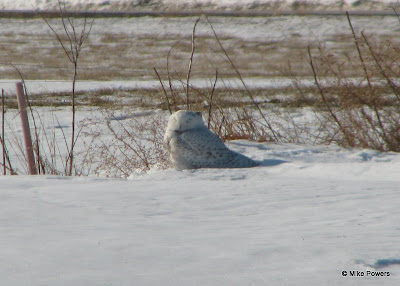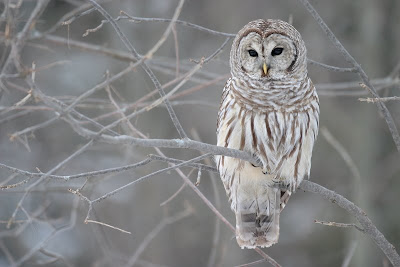Snowies are a nomadic species and often unpredictable migrant, its movements are thought to relate to the variable abundance of its main prey species, lemmings. As a winter migrant, it is more regular and abundant in the northern Great Plains than it is to the east, west and south of there.

General range map of the Snowy Owl. Map courtesy All About Birds.
Orange - breeding range, Blue - winter range.
Orange - breeding range, Blue - winter range.
Earlier in the winter there was a pair reliably reported on the south shore of Lake Ontario, a trip I was planning to take with Reina to see her first Snowies (and visit the grandparents while we were in the area, but we had our priorities). More recently there was a single bird frequently sitting right off the shoulder of State Route 20A, ninety minutes from our place. That bird turned out to be the "lifer" Reina, Donna, and friends stumbled across while driving to Toronto a couple of weeks ago.
A current eBird map for this winter shows they are fairly widespread with fairly frequent reports coming in from across New York; listserve posts indicate the same. One post (which has been followed by a dozen more) caught my attention: a Snowy Owl was reported in a field between Seneca and Cayuga Lakes, less than an hour from us.
 eBird reports of Snowy Owls across New England.
eBird reports of Snowy Owls across New England.Red - sightings from December, 2008; yellow - sightings from January 2009.
Considering I drive between those two lakes every day to and from work, that reported owl is practically on my commute. I'm stretching it a bit, I had to head north quite a ways to be in the right area, but leaving a early one morning ensured I didn't lose too much of the work day. Listserve directions indicated an intersection of two roads which I found fairly easily, but not immediately -- ever notice that rural roads may have multiple names, not always coinciding with names listed on maps or driving directions?
Upon arrival I employed my usual search strategy, looking for anyone that looks like they're watching birds. If that fails I try and remember descriptions or landmarks that folks wrote in their posts.
The roads were covered in blown snow but clear of traffic. The fields, large and expansive, were covered in drifts and dotted by large rolls of hay. No wonder this bird was here, it certainly felt like the windswept hummocks in the Arctic barrens it calls home in the breeding season. Many previous visitors had reported Short-eared Owls perched alongside of the hay, my eyes were peeled for them as well.
I drove slowly along the road, heading west. Each conspicuous lump of snow was merely a conspicuous lump of snow, shadowy and unmoving. Red-tailed Hawks, perched in far-away woodlots, monitored the open areas as a Pileated Woodpecker bobbed across a large expanse of the treeless fields. An American Kestrel gripped a wire, eyes focused on a drainage ditch along the road. A few Wild Turkeys perched along side and on top of the hay bales.
Recrossing my prime meridian for the morning I continued east from the intersection, cursing how well camouflaged this predominantly white, large owl could be. Later I would appreciate it, but at the moment it was frustrating. I stopped to look at another lump of snow, suspiciously rounded when compared to the other, sharper-edged drifts. This looked too smooth to be like the rest of the landscape, maybe like Telly Savalas standing among ice-covered stalagmites. (Not sure who Telly Savalas is? Substitute one of the following: Moby, John Malkovich, Michael Stipe, Patrick Stewart, Winston Churchill, or Sinéad O'Connor). Sure enough, not 100 meters east of the intersection, not 50 meters south from the road, was the owl perching on a drift, face turned towards the sun.
 Sometimes you just have to take in how good the sun feels.
Sometimes you just have to take in how good the sun feels.Does this position remind anyone else of this image from Birdy
(1984 movie with Matthew Modine and Nicolas Cage)?
I slowly coasted on to the shoulder and turned off the engine. Then back on so I could put the window down, then off again. I stayed in the car for two reasons. There was no reason to get out, I had a stellar view from the driver's seat, but mostly I was a bit wary of disturbing the bird as it was so close to the road. Wildlife rehabilitators often report many Snowy Owls brought to them during irruption years are starving, I figure the bird should keep focused on finding food and preserving its energy.
I spent about twenty minutes with the owl. I sat in my car blind, my eyes almost always on the bird, either through binoculars or a camera lens. The only audible traffic was the clomping footsteps from a horse-drawn carriage. The bird barely peeked at me, primarily facing the eastern sun, as though ensuring an even tan. I'm not sure I ever saw the owl's eyes. The couple of times he looked over the eyes were slits, a Clint Eastwood impression from the owl world. I'm not sure how the owl felt about me, but he sure made my day.
BNA Online excerpts about the Snowy Owl:
- The Snowy Owl is largely diurnal and hunts in all weather during winter and the continuous light of arctic summer. Although these birds often hunt by day, John J. Audubon included them in the only nocturnal scene that he painted.
- Snowy owls were formerly placed in genus Nyctea based on plumage, osteological (skull) characters, and DNA. Based on new genetic evidence they are now considered closely related to the Bubo owls, such as the Eurasian Eagle Owl of Europe and Asia and the Great Horned Owl of the Americas.
- Pairs may actually form on the wintering grounds in the northern Great Plains before departing for breeding areas farther north. In one study, the start of courtship was noted as early as midwinter in southern Alberta, but whether pairs actually bond there and arrive together on the breeding ground is debatable.
- Snowy Owls do not swim as a rule, although they can swim at least short distances. One large but flightless young was observed to leap into the water of a lake, and by using both wings made it across the deep waters to the opposite shore “some 50 feet away,” where it escaped pursuit.
- All About Birds (free)
- BNA Online (subscription required)
- The Owl Pages (free)
- Thoughts on Snowy Owl Plumage (sex and age)
-














